|
The Stevens family are well remembered for
their vehicle manufacturing company A.J.S. but the less
glamorous Stevens Screw Company has almost been forgotten. Both
companies have the same roots and their histories are entwined.
It all started in 1874 when Joseph Stevens
founded J. Stevens & Company in Cross Street, Wednesfield. He
was an engineering blacksmith who not only did the traditional
work of horse shoeing and making parts for harnesses and bridles
but also repaired all kinds of things. He could turn his hand to
almost anything and repaired all kinds of metal equipment,
wheelbarrows, garden tools, bicycles and did work for the lock
trade, which was booming in those days. When old enough, his
eldest son Harry joined the business and quickly became
proficient. He was a fast learner and soon began producing
special purpose machine tools for the lock trade.
In 1894 the business moved to Tempest
Street in the centre of Wolverhampton and Harry and his father
were joined Harry’s younger brother Joe. An American “Mitchell”
single cylinder four stroke petrol engine was purchased to
provide the draught for the hearth, but it was unreliable and a
poor performer. Harry being dissatisfied with its performance
decided to build his own. It was completed towards the end of
1897 and worked extremely well producing 1.75h.p.
Harry and his father were quick to
recognise the huge potential market that existed for petrol
engines to power all kinds of machinery and so in 1899 they
formed the Stevens Motor Manufacturing Company alongside the
existing J. Stevens & Company.
|
|
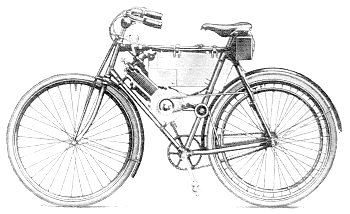
Harry's first motorcycle using the
'Mitchell' engine.
|
Around this time Harry turned his attention to a
motor powered cycle. He fitted the “Mitchell” engine to an old
B.S.A. bicycle that had been lying in the works, and apart from
the temperamental engine it was a great success. At the time J.
Stevens & Company were making spokes and screws for the
successful Wearwell Cycle Company of Wolverhampton. William
Clarke who ran the company was keen to produce a motorised
machine. |
| He was interested in Harry’s prototype and soon
a contract was drawn up between Wearwell and the Stevens Motor
Manufacturing Company for the production of a suitable engine.
The contract assured a regular order for engines and the first
Wearwell-Stevens machines appeared in 1901.
The new machine was a great success and a range of Stevens
engines were developed. Larger premises were soon necessary and
so in February 1904 the Tempest Street premises were vacated in
favour of a larger site in Pelham Street. Later that year the
decision was taken to form a Limited Company to encompass the
interests of both the Stevens Motor Manufacturing Company and J.
Stevens and Company. The new Company, known as the Stevens Motor
Manufacturing Company Limited was registered on 10th
December, 1904 with a maximum share capital of £5,000. The
shareholders were Joseph Stevens Snr.; W. Barnett, a partner
with Joseph Stevens in J. Stevens & Co.; Harry Stevens; W.H.
Haden, gentleman; George Stevens; T.E. Lowe, accountant and
F.R.W. Haywood, solicitor. The Company Directors were Joseph
Stevens Snr., W. Barnett and W.H. Haden.
Although things initially went very well for the new company,
a reduction in sales led to financial difficulties during the
summer of 1905. In order to safeguard the screw, rivet and small
turned parts side of the business, a new company, The Stevens
Screw Company Limited was formed early in 1906 and premises were
acquired in Retreat Street. The company was run by Joseph
Stevens Snr. and his daughters Lily and Daisy. |
| Key to the map:
Number 1 = Original
Steven's Screw Company Limited's site stretching from Retreat
Street to the Penn Road with the two houses at the rear.
Number 2 = Premises
brought by the Stevens Brothers and occupied by A.J.S., Stevens
Brothers (Wolverhampton) Limited and Stevens Screw Company.
Number 3 = Premises
rented by Stevens Brothers (Wolverhampton) Limited from 1933 to
about 1956. |

| The location of the
family's premises in Retreat Street. |
|
|
About half a dozen people were employed in
the new factory producing small turned studs, rivets and screws,
mainly for the lock trade. Another speciality was screwed
engineer’s studs. Business grew and 2 or 3 years later several
new machines were installed to make small repetition parts.
There were two factory buildings made of wood and a brick built
office building. They are not shown on the 1903 Ordnance Survey
map and so must have been nearly new when the company moved in.
At the front in Retreat Street was the
largest factory building, the Capstan Shop, with the office
above. Below the office, in the centre, was a large doorway that
gave vehicles direct access into the works. On one side of the
doorway were the stores and the cleansing room. Behind the
Capstan Shop was the Screw Shop where the screw studs and lock
studs were made and behind this facing on to Penn Road were two
houses that were occupied at one time or another by family
members. Joseph Stevens Snr. and his family occupied one of them
in the early years.
The screws, nuts and bolts were made from
bar on capstans and the lock studs were turned on machines that
were designed by Harry Stevens using a revolving dye head. They
were a great success and in use for many years. In the cleansing
room the products were cleaned in paraffin and sieved to remove
any swarf etc.
|
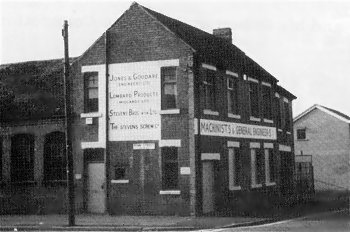
| The premises on the
corner of Retreat Street and Penn Street that was
purchased by the Stevens brothers. Courtesy of the late Geoff
Stevens. |
|
In 1909 Joseph’s 4 eldest sons, Harry, George
Joseph and Albert John also moved into Retreat Street in
premises across the road. They had recently founded a new
company called A.J. Stevens & Company Limited and acquired the
premises to manufacture motorcycles. The new machines
manufactured under the name of A.J.S. were extremely successful
and orders flooded in. By 1915 larger premises were essential
and the brothers purchased Graiseley House and the surrounding
land on which to build a new factory. |
| They left Retreat Street in 1917 and allowed the
Stevens Screw Company to use their building for additional
workshop space.
Joseph Stevens youngest son Billie joined-up after the outset
of the war and saw service in Salonika and the Dardanelles. When
he returned home his father immediately appointed him as a
director of the Stevens Screw Company Limited and his brothers
offered him a managerial post at A.J.S. in charge of spares and
the export department.
|
|

An advert from 1929. |
The late 1920s and early 1930s was a bad
time for vehicle manufacturers due to the recession. At A.J.S.
sales declined and the company went into voluntary liquidation
in 1931.
The following year the five Stevens brothers formed a
new company, Stevens Brothers (Wolverhampton) Limited and moved
back into their premises on the corner of Retreat Street and
Penn Street.
During the next few years they manufactured a
three-wheeled van and Stevens motorcycles. Van production ended
in 1936 and motorcycles were built until 1938 when the company
decided to concentrate on general engineering. During the war
they manufactured and machined components for most of the
leading aircraft companies and were sole manufacturers of the
torpedo setting gear for the Fairey Swordfish torpedo bombers. |
| By the late 1930s age was catching up with
Joseph Stevens Snr. and his youngest son Billie took over the
running of the Stevens Screw Company Limited. In 1938 his son
Jim started work at Stevens Brothers. |
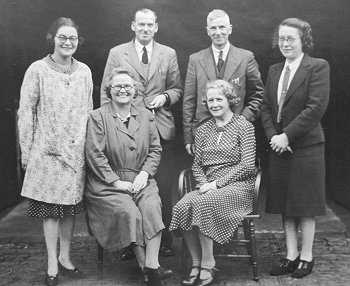
The Directors of the Stevens Screw Company
Limited in 1948. Courtesy of Jim Stevens. |
Standing Left to Right:
Daisy Jones daughter of Lucy Stevens, William Stevens (Billie),
William Simpson who was married to Ethel Stevens, and Gladys
Barrett - Daisy Jones' sister.
Seated Left to Right:
Lily Wood née Stevens, Daisy Weir née Stevens. |
Standing Left to Right:
Daisy Jones daughter of Lucy Stevens, Freddie Hunting who was in
charge of the Capstan Shop, William Stevens (Billie), Jack
Hunting (son of Freddie) who was in charge of the Screw Shop,
Horace Bowdler - Works Manager, William Simpson who was married
to Ethel Stevens, and Gladys Barrett - Daisy Jones' sister.
Seated Left to Right:
Lily Wood née Stevens, Daisy Weir née Stevens.
|
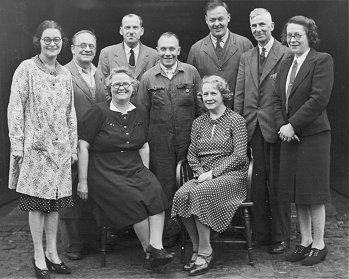
The Directors and key staff of the Stevens
Screw
Company Limited in 1948. Courtesy of Jim Stevens. |
|
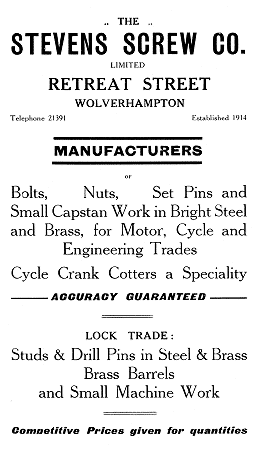
An advert from 1951. |
The Stevens Screw Company Limited continued to be
successful and by the early 1950s there were over 70 staff.
Production consisted of hundreds of different small parts
including bolts, nuts and screws in ferrous and non-ferrous
metals made from the bar.
They were supplied to the motor,
cycle, electrical, general engineering and lock trades. Many of
the customers purchased components for export. Most of the
workforce was female apart from the male setters. |
|
In 1956 Jim Stevens was appointed a
director of Stevens Screw Company Limited following the death of
his father Billie and was made responsible for running the
company. The decision was made to sell Stevens Brothers
(Wolverhampton) Limited, his father and uncles having died, and
to concentrate on the running of the screw company.
The main customer at the time was Wilkins
and Mitchell Limited of Darlaston and many of the Stevens’
components found their way into Wilkins and Mitchell’s ‘Servis’
washing machines. Other important customers were Rothley Brass
who manufactured brass door fittings and bathroom fittings; and
the Moss Gear Company.
By the 1970s most of the screw company’s
customers had gone into liquidation and the company slimmed down
considerably. Jim Steven’s was responsible for running the works
and his wife Joan the office.
|
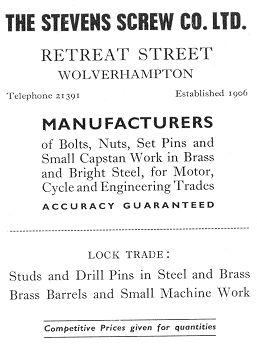
An advert from 1953.
|
|
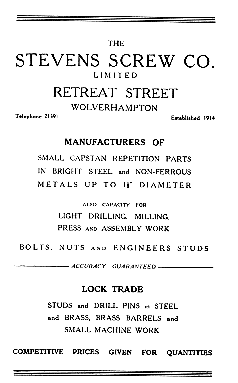
An advert from 1958.
|
Most of the shareholders were family
members who used to work for the company and had now retired.
After the company’s A.G.M. in 1973 their accountant suggested
that Jim and Joan should buy the other shareholders out and this
they did forming a new company called The Stevens Screw Company
(no longer a Limited company).
A little while later Wolverhampton Council
served a Compulsory Purchase Order on the old buildings which
were to be demolished to make way for a new car park for the
nearby Midland Counties Dairy. By this time Stevens Brothers had
been sold to Leo Davenport and he offered to share the premises
with the screw company. Later in 1973 they moved across the road
and sub-contracted much of their work to Leo’s company.
By the 1990s the screw company was
experiencing difficulties, with several of their customers going
into receivership. Jim and Joan decided to concentrate on a
reduced customer base and work towards retirement.
|
In 1991 Jim and Joan decided to retire and close
the Retreat Street factory. After discussion with one of their
main customers Rothley Tube Limited, it was decided that instead
of disposing of all of the machinery, certain items could be
retained and a small machine shop set up on Rothley's site. Jim
would continue, and still continues to produce samples and
machined items, retaining the Stevens Screw Company, which will
exist until Jim decides to call it a day.
I would like to thank Jim and Joan Stevens and the late Geoff Stevens
for their help in producing this history.

|
|
Return to the previous page |
|
|